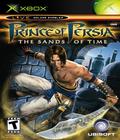In 1989, action-adventure gaming was born in a rather unlikely place - medieval Persia. With the release of Prince of Persia, Jordan Mechner unleashed a game that blended fast-paced arcade action with dramatic visual storytelling in a way that had never been seen before. The game went on to win thundering accolades, inspire a generation of gamers, and create a new genre in the fast-growing video game industry. The original Prince of Persia is the acknowledged inspiration for many later games, including Tomb Raider.
Now, fourteen years later, Mechner has returned as a collaborator on the highly-anticipated Prince of Persia: The Sands of Time - due out this holiday season from Ubisoft's Montreal studio. As scriptwriter, dialogue director, and creative consultant, Mechner moved from Los Angeles to Montreal to spend the summer months with the development team, immersing himself in a variety of production aspects.
The collaboration began in 2001 when Ubisoft approached Mechner with the idea of reviving the Prince of Persia license for next-generation consoles. According to him, "My biggest concern was that if there was to be a new Prince of Persia game, it had to be something special and not just mapping the Prince character and universe onto a kind of game that had been done already. The surprise, and it was a pleasant one, was to discover that Ubi Soft felt the same way."
Mechner visited the studio to meet the team, and saw some preliminary animations created by the team. "I was blown away by what they had done," he recalls.
Although video games have evolved considerably since Mechner created the first Prince of Persia, he still believes in the specific core elements that, to him, define a successful game. As Mechner explains, "A game needs to offer the player the satisfaction of building his skills throughout the game. By the final levels, he (or she) must be capable of performing feats that would have been far beyond his capabilities in the beginning. That's where the joy is. If you don't have that sense of accomplishment, you don't have much of a game. At the same time, playing a game should feel like fun, not punishment. It's the game's job to teach the player how to play."
"As a player I want to be captivated by an overall artistic experience, not just a commercial product. I want to feel that the game creators have something to express, and that by playing through to the end I will discover their personal vision. I look for elegance, attention to detail, unity of story and game design as key values, and if I don't find them I tend to lose interest quickly. I hope that all gamers, casual or hardcore, will see and appreciate these qualities in Prince of Persia: The Sands of Time."
"As a game designer my speciality is telling a story in a cinematic way within the game itself, and not just in cinematic cutscenes. The story has undergone a continuous process of revision, mostly in the direction of tightening, making it cleaner and stronger, bringing out the emotions of the characters, and of course, reflecting the ongoing changes in game design and level design. I'm extremely proud that the screenplay is so tightly welded to the game play. The story drives the game, and the game play drives the story."
Mechner and the rest of the team took pains to ensure that, in addition to representing an evolution to meet the expectations of today's console gamers, Prince of Persia: The Sands of Time would remain true to the elements that transformed the first game into a legend: fluid animations, ingenious and challenging level design, and a compelling hero to whom players could relate. As Mechner explains, "A key element in the success of POP 1 is the sheer exhilaration of movement. The feeling that you are one with the animated character on the screen, that you are not just going through mechanical motions to complete the level, but that you're flying-a feeling of joy in your own acrobatic grace. This is much harder to achieve today in 3D for a number of reasons, and it is one of the key values that I hope will excite people when they see Prince of Persia: The Sands of Time."
A Man of Many Talents
In addition to his groundbreaking work on video games, Mechner is also an accomplished filmmaker. His latest project, a documentary titled Chavez Ravine: A Los Angeles Story, examines a legendary, vanished Mexican-American neighborhood that was destroyed in the 1950s to make way for Dodger stadium. Directed by Mechner, the film features music by Ry Cooder, narration by Cheech Marin, and photography by Don Normark. His short film Waiting for Dark, filmed in Havana, Cuba, and produced and edited in Paris, won prizes at international festivals including Bilbao, Havana, Philadelphia, and Bahia.
Like a good film, the creation of Prince of Persia: The Sands of Time has been, at its heart, a collaborative process. According to Mechner, "This has been one of those rare experiences where a great team and a great idea come together and create something that is more than the sum of its parts."
More articles about Prince of Persia: The Sands of Time











 A rogue prince reluctantly joins forces with a mysterious princess and together, they race against dark forces to safeguard an ancient dagger capable of releasing the Sands of Time, which can reverse time and allow its possessor to rule the world.
A rogue prince reluctantly joins forces with a mysterious princess and together, they race against dark forces to safeguard an ancient dagger capable of releasing the Sands of Time, which can reverse time and allow its possessor to rule the world.





























